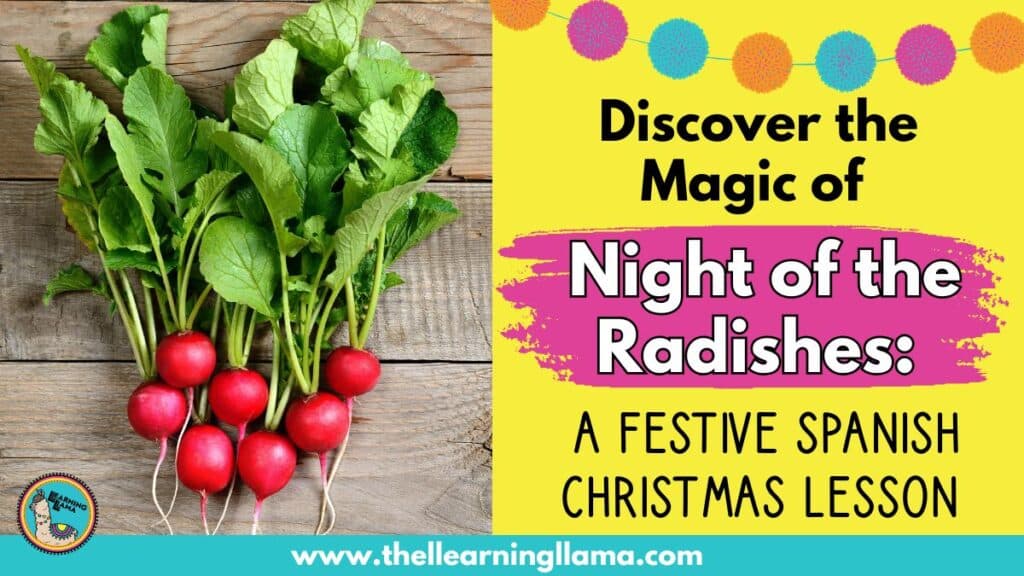You’ve probably heard of La Tomatina, a famous Spanish food festival. But have you heard of “La Noche de Rábanos?” This unique festival, NIght of the Radishes, takes place in Oaxaca, Mexico every year on December 23.
By teaching about Night of the Radishes, your Spanish students will get insight into a fun, cultural Christmas event in Mexico. If you’re looking for some ideas to freshen up your Navidad lesson plans, this is a unique way to add culture! Check out my tips below.
What is Noche de Rábanos?
Every year on December 23 in Oaxaca, Mexico, artisans gather to create beautifully designed sculptures out of… radishes! For over 100 years, this cultural festival has taken place in the town center. For just a few short hours, the artisans display their intricate designs before they begin to rot. The carved radishes show religious scenes, depictions of daily life, and cultural elements.
Start with an opening question
Ask a very simple question to begin your lesson: “What festivals or holidays are associated with food?” Hopefully students will dig deeper than “Thanksgiving.” But that is a good start. Some students may mention local festivals or fairs like a Strawberry Festival or Italian Festival. Others may even celebrate holidays with their family that center around certain foods. Give your students the opportunity to share and to share why these days are meaningful.
Important Vocabulary
When you teach about Noche de rábanos, you will need to introduce some important vocabulary so students can discuss this exciting festival. Here are some important vocabulary terms you will want to teach your students: Rábanos, Hortelanos, Esculpir, Tallar, Juez, Concurso, Zócalo, Ganador/a, Se parece, and Escultura.
Content to Teach for Night of the Radishes
To begin, you want to introduce the details of this festival, including the purpose, history, and day-of info. For a complete lesson on Night of the Radishes, you can get my resource here. It includes a reading with 3 differentiated versions, 3 vocabulary worksheets, comprehension questions, 3 summary activities, a PPT with images and videos!

And if you want to add Night of the Radishes to your Christmas lesson plans, get more resources with this money saving Navidad bundle.
I also recommend showing media, either videos or images. This way, students will be able to comprehend the beauty of this event and the incredible scenery carved into these vegetables. This video from Rosetta Stone is in English, but she interviews people in Spanish. This YouTube short gives a quick summary of the festival. And this YouTube short shows how huge the radishes are in the fields!
Just as important as videos are images! On Google Images, search “noche de los rábanos” Students can do their own searches and share their favorite sculptures. For a fun, authentic task, you can print pictures (or have Chromebooks set up around the room displaying one large image each). Students will circulate around the room and vote for their favorite carved radishes!

Use Your 5 Senses to Imagine You are at Night of the Radishes
This activity is one that I like to do often throughout the year. Having students utilize their 5 senses allows them to really put themselves into the situation. Sometimes we use our 5 senses when looking at an artwork, studying a festival, or even when doing creative writing. Students can first brainstorm by themselves, then share with a small group. Then, each small group can share aloud what they think they would see, taste, touch, smell, and feel at Noche de rábanos.
El rábano que escapó
Read this fun children’s book, El rábbano que escapó, with your students about the radish that escaped! It is reminiscent of The Gingerbread Man and uses a lot of vocabulary associated with Night of the Radishes. It is a past tense story, so better suited for advanced students. But it includes a lot of repetition, making it fun for students to listen along to!

Carve Your Own Radishes
Have your own Noche de rabanos competition with your students! Pick up some radishes from your local grocery store. Provide students with toothpicks, plastic knives, and popsicle sticks. Let them carve away! Then, put them on display around the room and have students vote for their favorites! The winners can be awarded a prize for extra motivation.
For some inspiration, check out these incredible, creative sculptures from Beth Henman’s classes from Westerville North High School. These students watched videos about Noche de rábanos, carved their own, and then crowned the winner!

3 Ps of Culture
The 3 Ps of culture, are an ACTFL are a cultural framework that demonstrates the importance in the connection between products, practices, and perspectives of a culture. Have students identify the 3 Ps of Night of the Radishes. This should be done after teaching about the festival (or as you teach the content, students can be thinking of this!).
Examples of the 3 Ps:
- Products; radishes, water sprayer, artisans, gardeners, town center, knives
- Practices; carve radishes, gather in the town square, judges vote, visitors admire,
- Perspectives: historical event – used to attract more people to the market; cultural event – part of Christmas traditions

Compare Night of the Radishes to Other Food Festivals
Once students have completed a lesson on Noche de rábanos, now reflect back on the first question you asked: What festivals and holidays are associated with food? Students should choose one to compare and contrast to Night of the Radishes. In the past, I taught this unit alongside a “La Tomatina” lesson during a Food Festivals unit. After teaching about both separately, I ask students to compare the two and choose which one they would like to attend and explain why.

If you are interested in teaching about other food lessons and activities, then check out this blog post: The Complete Collection of 15 Food Activities for Spanish Class. And here is a comprehensive guide of Christmas Activities for Spanish class.





